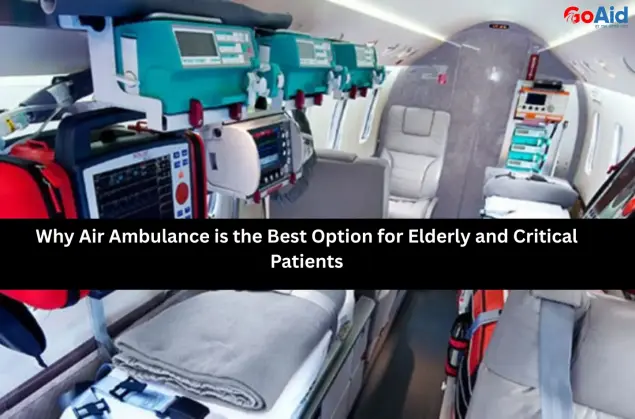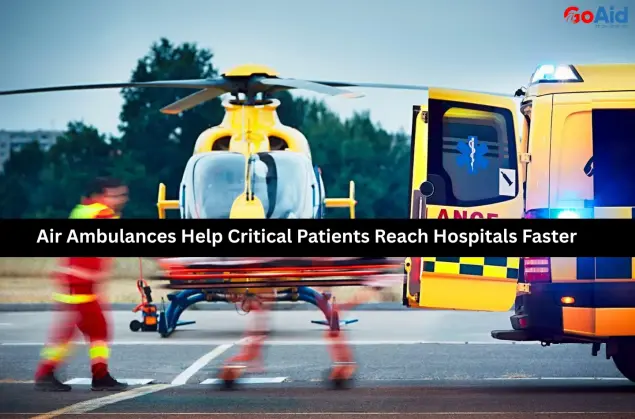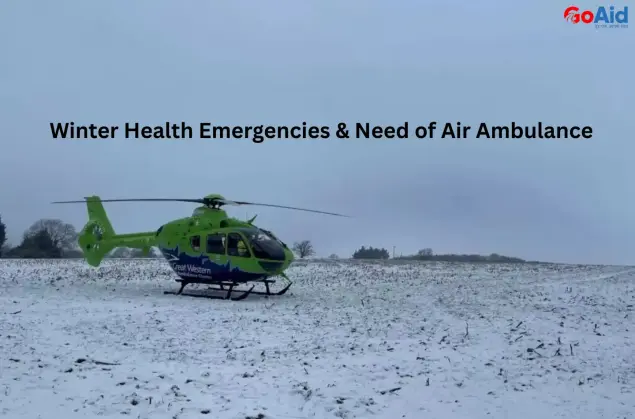What is an Air Ambulance?
An air ambulance is a medically equipped aircraft designed to transport patients safely and quickly during emergencies. It provides critical care in-flight, with specialized medical equipment, ventilators, oxygen support, and monitoring systems comparable to hospital ICUs.
Air ambulances are used for inter-hospital transfers, remote or inaccessible locations, and international medical evacuations. Staffed by trained paramedics, nurses, and doctors, these aircraft ensure continuous monitoring and life-saving interventions during transit.
Patients benefit from faster travel compared to ground ambulances. This reduces delays in receiving urgent medical care. Air ambulances are a vital solution for time-sensitive emergencies, combining speed, safety, and professional in-flight medical support.
Types of Air Ambulances in India
India offers a variety of air ambulance services to meet different patient needs, urgency levels, and medical conditions. This ensures safe and reliable transfers across distances.
Normal Air Ambulance
Ideal for stable patients, normal air ambulances provide basic medical monitoring and oxygen support during transit. They ensure comfortable, safe travel for non-critical patients. This makes them an affordable and efficient choice.
ICU Air Ambulance
Equipped with ventilators, cardiac monitors, infusion pumps, and advanced life-support systems, ICU air ambulances handle critically ill patients. A trained ICU medical team monitors and manages patient care throughout the flight.
Helicopter Air Ambulance
Helicopters are perfect for rapid transfers from remote or hard-to-reach areas. They offer vertical lift capability, fast response, and essential onboard equipment for urgent patient evacuations.
Private Jet Air Ambulance
Private jets provide maximum comfort and privacy, suitable for long-distance or international transfers. Fully equipped with ICU facilities, these jets ensure continuous monitoring and professional care during the journey.
Step-by-Step Patient Transfer Process
The patient transfer process via air ambulance is carefully structured to ensure safety, efficiency, and continuous medical care. GoAid follows a stepwise approach to guarantee smooth and reliable patient transfers.
Step 1: Initial Contact
Families or hospitals contact GoAid via app or helpline. Patient details, medical condition, location, and urgency are collected for proper assessment and planning of the transfer.
Step 2: Assessment and Planning
Medical professionals evaluate the patient’s condition to determine the suitable air ambulance type, required ICU support, and onboard medical staff for a safe journey.
Step 3: Aircraft Preparation
The appropriate aircraft—normal, ICU, helicopter, or private jet—is prepared with necessary medical equipment, supplies, and medications before departure.
Step 4: Medical Team Assignment
Skilled doctors, nurses, and paramedics are assigned according to patient needs. They coordinate with the operations team to ensure readiness and continuous in-flight care.
Step 5: Ground Ambulance Transfer
The patient is safely moved from home or hospital to the aircraft via ground ambulance, maintaining stability and comfort throughout the journey.
Step 6: Boarding and In-Flight Monitoring
Upon boarding, the medical team monitors vital signs, administers treatment, and ensures patient comfort throughout the flight to the destination.
Step 7: Coordination with Receiving Hospital
GoAid communicates with the destination hospital in advance to ensure a prepared ICU or emergency team for immediate patient care on arrival.
Step 8: Safe Handover
Upon landing, the patient is transferred safely to the receiving hospital or facility with complete medical documentation and a briefing for hospital staff.
Pre-Transfer Medical Assessment
Before any air ambulance transfer, GoAid conducts a thorough pre-transfer medical assessment to evaluate the patient’s stability and determine the necessary medical support during transit.
Doctors review patient history, current condition, vital signs, and treatment requirements. Critical factors such as oxygen needs, ventilator dependency, cardiac monitoring, and medication administration are assessed.
The assessment helps select the appropriate type of air ambulance—normal, ICU, helicopter, or private jet—and the medical team required onboard. It ensures all potential risks are anticipated and mitigated.
Families are informed about patient condition, estimated travel time, and necessary preparations. This ensures a smooth, safe, and well-coordinated transfer from origin to destination.
Equipment and ICU Facilities on Board
GoAid air ambulances are equipped with advanced ICU facilities, replicating hospital-level care in the air. Equipment includes ventilators, oxygen cylinders, infusion pumps, cardiac monitors, defibrillators, and emergency medications.
Critical care devices allow continuous monitoring and life-saving interventions during flight. Each aircraft carries necessary consumables, emergency kits, and patient comfort aids. ICU setups are tailored to patient needs.
This ensures safe transport for critically ill patients, post-surgery patients, or those requiring constant medical attention.
The combination of advanced equipment and trained medical staff onboard ensures uninterrupted medical support. This makes GoAid a trusted choice for both domestic and international patient transfers.
Role of Paramedics and Medical Staff
Paramedics and medical staff play a vital role in ensuring patient safety, monitoring, and care throughout the air ambulance journey.
- Continuous Monitoring
Paramedics constantly track vital signs like heart rate, oxygen levels, and blood pressure to detect any changes requiring immediate attention.
- Administer Medications
They provide required medications, IV fluids, and oxygen therapy as prescribed by the supervising doctor during transit.
- Emergency Response
Trained staff can handle sudden medical emergencies, performing interventions like CPR, defibrillation, or advanced airway management mid-flight.
- Patient Comfort
Medical staff ensures patients remain comfortable and stable, adjusting support equipment, positioning, and providing reassurance throughout the journey.
- Communication with Hospital
They maintain real-time updates with the receiving hospital, coordinating for smooth admission and preparedness on arrival.
- Documentation and Records
Paramedics maintain detailed in-flight medical records, noting interventions, vitals, and treatments to ensure continuity of care.
- Equipment Management
They handle all onboard medical devices. This ensures correct operation, proper monitoring, and immediate response to any technical issues.
Communication and Updates for Families
GoAid ensures families are kept informed throughout the air ambulance transfer process. From booking to landing, they receive regular updates on patient condition, estimated time of arrival, and in-flight status.
Medical staff communicates critical changes and provides reassurance to reduce stress. Families can track the aircraft, receive guidance for hospital admission, and understand treatment provided during transit.
GoAid’s transparent communication builds trust, ensures accountability, and helps families plan effectively for the patient’s arrival. This continuous engagement provides peace of mind while guaranteeing that the patient is monitored, safe, and cared for professionally during every stage of the air ambulance journey.
Booking an Air Ambulance with GoAid
Booking a GoAid Air Ambulance is quick and convenient. This ensures immediate access to medical transfers with professional support, advanced equipment, and trained medical staff anywhere in India.
Book By Call – Dial 8008280020
Families or hospitals can call GoAid’s helpline at 8008280020 for instant assistance. Trained representatives gather patient details, location, and medical condition, guide through service options, and coordinate aircraft, medical staff, and ground transfer for a smooth and timely journey.
Book By App – Download GoAid App
The GoAid App allows easy air ambulance booking. Users enter patient information, location, and medical requirements. The system confirms availability, assigns medical staff, and provides updates. This ensures fast, stress-free coordination for domestic or international transfers.
International vs Domestic Air Ambulance Transfers
Air ambulance transfers can be domestic or international, depending on the patient’s treatment needs, location, and urgency. Both ensure safe and professional patient transport, but differ in scope and logistics.
International Air Ambulance Transfer
GoAid organizes international transfers for patients needing specialized treatment abroad. These flights include full ICU facilities, trained medical teams, flight coordination with authorities, and in-flight patient care.
Families receive guidance on documentation, travel clearances, and hospital coordination. This ensures smooth, timely, and safe cross-border transfers.
Domestic Air Ambulance Transfer
Domestic transfers cover inter-city or inter-state patient movement within India. Aircraft are equipped based on medical needs, with paramedics monitoring patients en route.
Rapid response, 10-minute activation, and 24/7 availability ensure patients reach hospitals efficiently while maintaining high standards of in-flight care.
Comparison of Both
International transfers involve longer flight durations, additional regulatory clearances, and coordination with foreign hospitals. Domestic transfers are faster, simpler, and focus on speed, accessibility, and patient comfort.
Both utilize ICU facilities, trained medical teams, and safety protocols. International flights demand detailed pre-transfer assessments, visa/document handling, and communication with foreign authorities. Domestic transfers prioritize rapid response and optimized routes within India.
Despite differences, GoAid ensures safety, advanced equipment, continuous monitoring, and family communication for all transfers. Families can rely on GoAid’s expertise for both domestic and international journeys. This ensures patients receive timely, professional, and reliable care regardless of distance.
Safety Protocols During Transfers
GoAid prioritizes patient safety through strict protocols. Aircraft are sanitized and checked before every flight. Medical equipment, including ventilators, monitors, and emergency kits, is fully functional. Trained paramedics and doctors handle patient positioning, monitoring, and emergency interventions.
Continuous communication with the receiving hospital ensures preparedness. Safety measures also include pre-flight medical assessment, weather checks, and secure in-flight patient handling. Families are informed of patient condition and updates throughout the journey.
These comprehensive measures reduce risks, ensure professional care, and maintain the highest standards of safety during both domestic and international air ambulance transfers.
Conclusion
In conclusion, we have provided you all the details about How Does an Air Ambulance Work and a complete guide for patients and families. From types of aircraft, ICU facilities, paramedic roles, to domestic and international transfers, GoAid Air Ambulance ensures safe, reliable, and timely patient care.
Their easy booking, 24/7 availability, and strict safety protocols make medical air transport efficient and stress-free.
Families can trust GoAid for professional in-flight monitoring, seamless transfers, and compassionate support. This ensures peace of mind while patients receive critical care during every stage of their journey.
FAQs
Q1: How can I book a GoAid Air Ambulance?
A: You can book by calling 8008280020 or using the GoAid mobile app. Provide patient details, medical condition, and location, and the team coordinates aircraft, staff, and ground transfers.
Q2: What types of air ambulances are available?
A: GoAid offers normal air ambulances, ICU-equipped jets, helicopters, and private jets. Each option is equipped to meet specific patient needs, distance, and medical conditions.
Q3: Can GoAid handle international patient transfers?
A: Yes, GoAid provides international air ambulance services with ICU support, trained medical teams, flight coordination, documentation guidance, and hospital communication for safe cross-border transfers.
Q4: Are GoAid Air Ambulance services available 24/7?
A: Yes, GoAid operates round the clock, 365 days a year. Patients can access fast-response air ambulance services anytime. This ensures timely medical care during emergencies.
Q5: What safety protocols are followed during transfers?
A: GoAid follows strict safety protocols including pre-flight medical assessment, aircraft sanitization, functional ICU equipment, trained medical staff, secure patient handling, real-time monitoring, and hospital communication for maximum safety.




